Intrepid Ibex lays claim to the Black Tower
Last updated Nov 4, 2008 — 21677 views It finally happened: Ubuntu 8.10 (aka “Intrepid Ibex”) has uprooted Kubuntu 8.04 from the Black Tower. Although I’ve been a staunch KDE advocate for many years, this exceptional new distribution — based on Linux 2.6.27, GNOME 2.24, and X.Org 7.4 — has unexpectedly converted me into a GNOME user.
It finally happened: Ubuntu 8.10 (aka “Intrepid Ibex”) has uprooted Kubuntu 8.04 from the Black Tower. Although I’ve been a staunch KDE advocate for many years, this exceptional new distribution — based on Linux 2.6.27, GNOME 2.24, and X.Org 7.4 — has unexpectedly converted me into a GNOME user.
Some key new features and enhancements in the Ubuntu 8.10 release include:
- 3G wireless support — Improvements to the distribution’s network manager simplify detecting and connecting to 3G networks via built-in 3G modems, external “dongles,” mobile phones, and Bluetooth connections, and supports a wide range of popular devices.
- Writing Ubuntu to (and running it from) USB drives — A simple application now enables users to write Ubuntu to a USB drive — even a modified version that includes their personal data — so it can be plugged into and used on any PC or laptop.
- Guest sessions — Using this feature, a desktop session can be “locked down” so that a guest can use the full system without interfering with resident programs or data.
- BBC content — The standard Ubuntu media players (Totem Movie Player and Rhythmbox) now provide a menu of free, continually-updated BBC content, including high quality video, radio, and podcasts, much of which is playable using non-proprietary codecs.
- Updated GNOME desktop environment — Key new features in GNOME 2.24 include a new instant messaging client, a built-in time tracker, improved file management and toolbars, and better support for multiple monitors (including the ability to set screen resolution by monitor).
- Updated X Window System — X.Org version 7.4 now supports a wide range of hot-pluggable input devices such as tablets, keyboards, and mice, thus enabling “the great majority of users to run without a /etc/X11/xorg.conf file,” according to the Ubuntu.com website.
Additional details on what’s new in Ubuntu 8.10 may be found in the new features list and release notes on the Ubuntu.com website.
Test driving the new release
On learning of Ubuntu 8.10’s release, my initial reaction was to preview it as a live CD on the Black Tower, to see how well it performed. That way I could ensure that everything worked properly before upgrading the system’s KDE-based Kubuntu 8.04 OS to version 8.10.
But then something unexpected happened: I absent-mindedly downloaded Ubuntu 8.10 from Ubuntu.org instead getting Kubuntu 8.10 from Kubuntu.org. Part way through the download, I realized my mistake.
Instead of aborting the download, however, I decided to go ahead and preview standard Ubuntu 8.10 to see what it was like. After all, I’d read numerous comments suggesting that the standard GNOME version of Ubuntu offered superior functional integration to Kubuntu, Ubuntu’s KDE-based sibling. Who knew, maybe I’d like it!
After downloading the Ubuntu 8.10 ISO image file and burning it onto a CD, booted it up as a live CD within a VirtualBox virtual machine on the Black Tower, and checked it out. The screenshots below show what it looked like.
Ubuntu 8.10 live CD screenshots
(Click each thumbnail to enlarge)














Ubuntu 8.10 live CD screenshots
(Click each thumbnail to enlarge)
Everything seemed to work properly in the test. In fact, I liked what I saw enough to begin to contemplate doing a clean install of Ubuntu 8.10 (yes, the GNOME version) on the Black Tower.
Fresh from converting a cousin’s two aging Windows 98 PCs (a desktop and a laptop) to my favorite custom Debian/KDE Linux implementation, and having failed to find a single book to help him learn to use such a configuration, I’d already begun wondering whether KDE on Ubuntu — or on any other Debian variant — was too obscure to be well supported.
Combining this concern with what I’ve previously bemoaned as the sorry state of KDE 4, Kubuntu 8.10’s default desktop environment, I resolved to do a “clean install” of Ubuntu 8.10 on the Black Tower — to turn my back on KDE for the present, and give GNOME a whirl.
Installing Ubuntu 8.10 on the Black Tower
Before embarking on a clean install of Ubuntu 8.10 on the system, I performed my usual set of upgrade preparations. These included backing the system up to an external USB drive, and saving critical settings and data in a manner that would allow them to easily be restored following the upgrade.
The screenshots below show Ubuntu 8.10’s well-designed seven-step installation wizard in action. (Note: the images below were recorded later, while running the Ubuntu 8.10 live CD’s installation wizard within a VirtualBox virtual machine on the Black Tower’s Ubuntu 8.10 desktop.)
Ubuntu 8.10 installation wizard in action
(Click each thumbnail to enlarge)
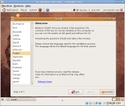
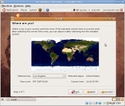
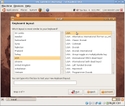
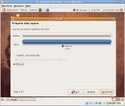
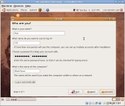
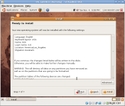
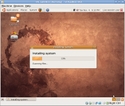
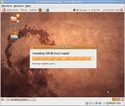
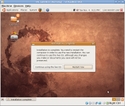
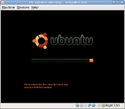
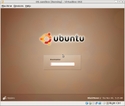
Ubuntu 8.10 installation wizard in action
(Click each thumgnail to enlarge)
GNOME configuration tweaks
Once the installation wizard completed its seven-step process (see above screenshots), a message at the top of the screen prompted me to perform a system update. After I responded affirmatively to that request, half-a-dozen packages (including the Linux kernel) were updated.
After that, a new message offered me the option of installing proprietary Nvidia video drivers in the system to optimize its video performance. I took the system up on this offer as well.
Next, I configured the GNOME desktop to my liking. The screenshot below shows the results.
The Black Tower’s Ubuntu 8.10 desktop
(Click image to enlarge)
As you can see in the above screenshot, I configured GNOME to have a single panel, at the bottom of the screen, for on-screen control functions and status messages. In contrast, GNOME by default spreads these functions between two panels, with some bits at the top of the screen and the rest at the bottom.
My preferred single-panel configuration, a DeviceGuru.com reader points out, is similar to how KDE does it. Maybe it’s due to using KDE (and before that, Windows) for so many years, but I like finding application-level control functions at the top of the screen (via the application-supplied top panel) and system-level control functions at the bottom (via the desktop manager-supplied bottom panel).
Fortunately, GNOME offers lots of flexibility in the location and contents of the desktop panels. You can even create panels on the right or left sides of the desktop.
Below are two alternative dual-panel desktop configurations I’ve been experimenting with. Each places application and menu icons on one panel, and window selection tabs on another.
An alternate GNOME desktop with top and bottom panels
(Click image to enlarge)
An alternate GNOME desktop with dual panels on the bottom
(Click image to enlarge)
Adding software
The repositories available to Ubuntu users for free downloading of software offer thousands of applications. Ubuntu 8.10 comes with a very complete basic set of programs preinstalled. To these, I added my favorites.
Before downloading additional software, I modified the repository lists contained in the /etc/apt/sources.list file. From the command line, I used the pico editor (as root) to do this.
The steps I followed were:
- Remove the “#” from the beginning of the lines in the file that start with “# deb” except for the first one, which starts with “#deb cdrom”.
- Add the Medibuntu repositories, using the procedures outlined at Medibuntu.org; this includes storing a “key” required for gaining access to the Medibuntu repositories.
If you prefer avoiding command line functions, you can edit the repositories list using the Settings tab of the Synaptic Package Manager (find it at Main Menu > System > Administration > Synaptic Package Manager).
Now it’s time to add various software packages.
I like to do this using the apt-get utility from the command line. You might prefer using Synaptic, pictured below, a user-friendly tool that shows categories of software available and even provides popularity ratings for each program.
Synaptic makes it extremely easy to install software on a Ubuntu system
(Click image to enlarge)
Just about all the software I eventually added to the Black Tower’s Ubuntu OS could be downloaded and installed with the following command:
- sudo apt-get install bluefish dillo xine-ui flashplugin-nonfree sun-java6-plugin ntfsprogs imagemagick build-essential acroread skype opera realplayer xine-ui amarok k3b amarok-engines thunderbird
These packages can also be installed using Synaptic — just search for them using the program’s Search function.
Traditional root
I also like to create a “traditional” linux root user account, instead of having to use “sudo” whenever I have to do an administrative task. It’s easy to do, but I won’t go into that here.
Tests
Finally, I performed a series of tests to verify that all key functions were working as desired. These included:
- Java plugin
- Adobe flash plugin
- Watching Youtube videos
- Making a Skype VoIP phone call
- Listening to Amarok Internet radio
- Printing with my HP LaserJet 1020
- Transfering files to/from my cellphone over Bluetooth
- Writing to/from an external USB drive (formatted as ntfs filesystem)
- Transfer photos from a camera over USB
Since the Black Tower doesn’t have a PCMCIA slot, I didn’t test the system’s ability to connect to the Internet over either WiFi or dialup. However, I did verify that both work well under Ubuntu 8.10 on my laptop system, an old-but-loved ThinkPad X20.
Finally, with some trepidation I tested suspend/resume to/from RAM. Thankfully, it worked fine!
Other observations
Here are a few additional points of interest:
- Following the standard Ubuntu 8.10 installation, plus the additional software I downloaded, the OS takes up 3.4GB on the hard drive.
- Most desktop launchers (icons) seem to lack the “busy cursor” function that indicates that an application is in the process of starting. Without a busy cursor, you might click an application and see no indication on the screen that anything is happening. To fix this, I found that I needed to edit quite a few applications’ desktop launcher files (e.g. “AdobeReader.desktop”) located in /home/rick/Desktop/ to add the line, “StartupNotify=true”.
- In order to view DVDs without constantly dropped frames (or skips), I had to set GNOME’s desktop Visual Effects to “none.” Perhaps that restriction will not be necessary in the future, but for now I’m not too concerned about the reduction in snazzy visual effects.
Conclusion
After about a week of heavy use, I find I’m liking Ubuntu 8.10 — with its GNOME 2.24 desktop environment and X.Org 7.4 X Window System — more and more with each passing day.
At this point I can safely say Ubuntu 8.10 is the best-performing Linux distribution I’ve ever used — from the perspective of functionality, usability, and aesthetics. And, much to my surprise, I’m really liking GNOME!


| WAIT!… Before you go, please take a moment to read the valuable comments made by readers, below. |
|---|




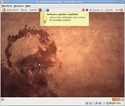
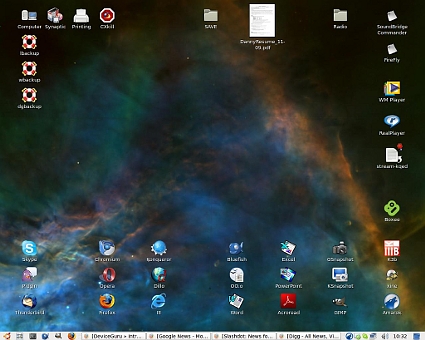
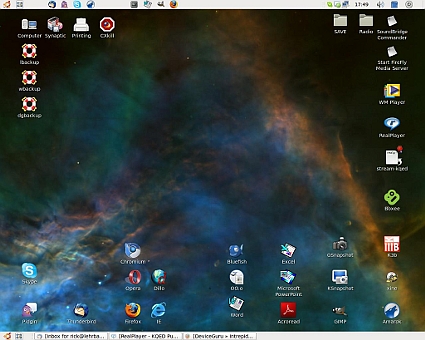
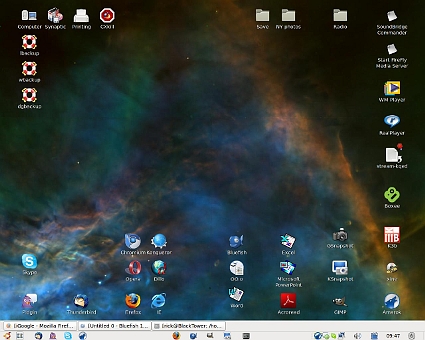
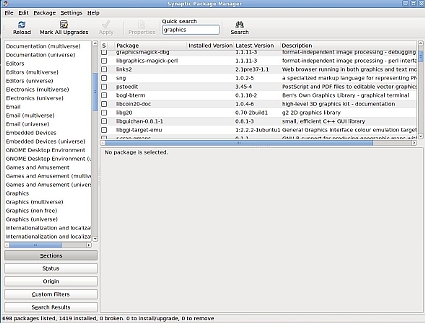
Nice review! I do like KDE4 as it is the future, but I’ve always been a Gnome fan. I noticed you downloaded and installed xine-ui twice, though. 😉 It is hard to argue that Ubuntu is THE distribution for the current time, just as Mandriva was not too long ago. I especially like the new functions/features of 8.10, but I won’t be upgrading my 8.04 version anytime soon. I also like the ability to install Ubuntu to a thumbdrive.
All in all, Ubuntu is what it is, and that’s a distribution meant for everyone, from the Linux newbies to the Linux guru’s.
while i like some of the Gnome’s interfaces more than KDE, id like to know if you did try Kubuntu 8.10. Im expecting an even better aesthetics and GUI Ubuntu. Ill try it myself when i receive my cd’s. nice review.
[Reply from DeviceGuru: Yes, before doing the clean install I tried a dist-upgrade of the Black Tower’s original Kubuntu 8.04 install to Kubuntu 8.10, and it substituted KDE 4.1.x for KDE 3.5.x. I’ve written about my experiences with KDE 4.1 before — it has lots of fancy GUI effects, but for my tastes it’s basically all frills and no substance.]
Interesting that you use the single Gnome panel at the bottom. I’ve never undertstood why any desktop would default to putting controls in two different places.
“BBC content — The standard Ubuntu media players (Totem Movie Player and Rhythmbox) now provide a menu of free, continually-updated BBC content, including high quality video, radio, and podcasts, much of which is playable using non-proprietary codecs.”
It does? I checked my enabled plugins in Totem and the BBC one was enabled. I’m a vlc man myself, but I simply could find no option to view this BBC content you speak of. Perhaps it only works within the UK.
Oh and I have to add (and please no offence intended) but that’s one *fugly* screen shot of your desktop.
Other than that, a very nice article and Welcome to the world of Gnome. I think you’re going to like it here.
BadOkami
@wally
When you have enough windows open, you appreciate not having the menus, launchers, notification area and clock stealing space from your window list.
Also, it’s better to absent-mindedly click and switch to the wrong window than to launch a (possibly resource-heavy) process.
@Zecc
You make an interesting point about the crowding up of a single panel. I’ve noticed the tendency for Linux to provide more and more status icons in the notification tray (on lower panel, at right). I’m experimenting with moving the app-launchers and status icons to the left edge, and having the window tabs at the bottom.
Interesting that you like everything on a bottom panel, me too! I have tried both KDE and Gnome but I have to say I enjoy using Gnome so much more. At this stage I am a long term Gnome user because it focuses on functionality and innovation rather than flashy features. You’re definitely not the only person who has switched from KDE to Gnome, its happening quite alot now.
Ubuntu 8.10 looks great but I will probably stick with the LTS edition… as everything “Just Works”. Nice review, very well written.
What I like abount Ubuntu is that I can get consistent Debian releases, with support for some stuff Debian will not include. I tend to install via the alternate CD and do a minimal text install and build up from that. Basically it is just like installing Debian. Lots of packages, and all around solid. I can build it the way I like it. I think I prefer Gnome, but I also like to install some of the minimalist window managers like wmii, dwm, awsome, and jwm as alternatives that I can log into. I also change the default Gnome to use just a single task bar/panel.
I used to LOVE KDE. I hated Gnome with a passion. Right up until I installed Hardy and made myself give Gnome a fair shake. Now I prefer Gnome. Of course, even in KDE, I used top and bottom panels. I put my most commonly launched apps on the top panel for one-click launching. (I HATE menus with a passion. I’d rather ALT+F2 and type the app name.) I also put the standard Ubuntu menus up top, and the notification tray/clock/calendar too. My bottom panel holds my window list, desktop switcher, and system monitors.
The improvements to Gnome have been great over the last couple of years. And now with tabs in Nautilus, it’s dang near perfect. In fact, flipping back to KDE now, I have trouble with it and find it unintuitive. And I used it for YEARS!
Admittedly, KDE4 hasn’t inspired me. It was part of the reason I flipped to Gnome in the first place, honestly. But 4.1 was a good improvement over the 4.0.x series. I hope by 4.3 or 4.4 they have a kick ass DE.
I was burned by KDE 4 since they removed lot’s of functionality.. I was angry and cursing at times, it is understandable some people switch to GNOME. But I have also compared 4.1 to 4.0 / 3.5x and it was much more beautiful. I am starting to love KDE 4.1 again. Give KDE 4.1 some more time and those who switch from KDE to GNOME will switch back again.
Great Review! Your experiences mirror lots of mine. I had been a die-hard KDE user, and switched from Slackware to Kubuntu back in 2005 when I wanted a 64-bit distro. 7.10 was horrible and I distro-hopped for a long time – tried lots of distro’s (both KDE and GNOME) and then I recently came back to Ubuntu (like you, the GNOME version). I initially tried Kubuntu (w/ KDE 4) and it was just horrible – I might wait a few releases and give KDE another shot, but I am happy with GNOME.
Also, like you I initially gave GNOME the “Single-Panel” treatment but I’ve actually grown to like the default GNOME layout more. Don’t knock it until you try it. It really doesn’t take up any more room than a “Normal” sized KDE panel, and I like the extra rooms for extra GNOME applets. I spend a great deal of time on Windows Machines at work, and I find myself wishing I could split up the windows taskbar to put the Start-Menu, Quicklaunch, System Tray and Clock at the top with the “task-bar” or “task-switcher” at the bottom – it really has become that intuitive to me. Of course, the great thing about Linux (and GNOME, and KDE) is that everything is configurable and you do have a choice as to how you set things up.
Again, thanks for the great review!
You lost me at you were a KDE fan and you used Kubuntu.
Kubuntu is not in my top 5 KDE distros.
Mandriva, PCLinuxOS and OpenSuse, Slackware, and Arch if you want a better KDE experience.
Ubuntu treats KDE users second class citizens, lagging a year behind on many features going into Ubuntu, or getting broken patches that are only occasionally sent upstream.
Telling someone about KDE and then making them use Kubuntu is like telling someone about Linux and giving them Linspire 😉
I agree about one thing: if I had to use Kubuntu I’d switch to disease ridden Mono-loving Gnome too.
I think Canonical should just give up on KDE rather than do a piss poor job at it.
And you proved that all these articles are useless since people do things the way they like it, not the way some companies tell them they will like. Who cares about wallpapers and taskbars that come by default.
Every single desktop I use both in Windows and Gnu-Linux look the same with the same wallpaper and a bottom taskbar that disappears when I work (I have wasted screen space so dont ask me about the cutesy big iconed Mac taskbar)
I like the Arch mention, that is probably my favorite distro. KDEmod is awesome as is Arch for it’s rolling release cycle.
@Rob Enderle
Uh, stress much?
If you’re such a KDE fanboy, that’s great. This is a stupid battle that has been going on for quite some time. It’s still Linux, no matter the desktop experience. How about XFCE, E17, WindowMaker, IceWM, et cetera?
If you want bleeding-edge KDE features, I’d suggest Gentoo, unless you think your hardware can’t handle it…
If you think KDE in Kubuntu needs help, then offer to help it yourself *BEFORE* trashing it.
So much for a useless article – *you* read it, right?
END OF LINE (Out Of Troll Feed)
Well – I can only agree what is said before…
Kubuntu is the ugly stepchild from Ubuntu. If the people at Canonical try to get users away from KDE they are doing a great job. If you take a look at the new KDE 4.2.1 on Mandriva 2009 and OpenSUSE you will see a shiney new desktop with all the bells and whiles of a new KDE (you can install the old 3.5 version also from the repository).
If you -however- try to Kubuntu 8.10 you get an environment where a lot of things go wrong. You cannot install the Nvidia drivers because the restricted drivers application wont elevate the rights to do so. When trying to run the application with sudo the whole plasma environment just crashes. After installing applications does not show up in the menu bar, and are not very stable. This list goes on and on…
Even the “old” Kubuntu 8.04 just feels very spartan and rough around the edges if you compare it to other distro’s. After being used to Mandriva, OpenSUSE, PCLinuxOS etc. Kubuntu just feels like it is been rushed out of the door just to keep those pesky KDE lovers quiet.
After using KDE4 for a while now (NOT on Kubuntu) I can’t escape the feeling Gnome is coming to a standstill while KDE is making big progress. It is too bad Kubuntu just does not get the same support from Canonical as Ubuntu gets. That gives me the feeling Kbuntu is lagging behind and sitting at a semi alpha stage forever.
However, this does not gives me the feeling I would switch to Gnome like the author has. Switching to Gnome for me is like giving up a little piece of freedom and progress. Gnome just feels too restricted and a bit conservative to me. No – it rather gives me the feeling to dish Ubuntu/Kubuntu all together. You know – as a KDE user I am getting the impression with Kubuntu I am treated like a second class citizen. That’s not a good feeling. If disto’s like PCLinuxOS, Mandriva etc. do a much better job in supporting all environments (and I mean not only Gnome and a halfhearted KDE) and considering some disto’s even have a smaller staff then Canonical, I think I am better off with them.
Don’t get me wrong – I have nothing against a good Gnome distro like Ubuntu, but as a KDE user I do not like Kubuntu at its present stage, because i KNOW it can be done much better. This does not let me switch to Ubuntu, but rather dish the *buntu family all together. If they don’t want to invest in all desktop environments like other distro’s do it looks like a sign to me some people have a narrow mind over there. And I feel uncomfortable with that impression.
Good review..
Only thing is the screenshot doesn’t show the classic “Synaptic”. What is on the screenshot is always referred to “Add or Remove Programs”. The synaptic interface is found under System > Administration > Synaptic Package manager
[Comment from DeviceGuru: Thanks for catching that error! I fixed the screenshot to show the classic Synaptic. The one I had there was from Main Menu > Add/Remove.]
If you are having trouble with DVD skipping then you might need to turn on DMA for the DVD drive.
To turn on DMA for the dvd drive where /dev/hdc is your DVD drive:
sudo echo “sbin/hdparm -d1 /dev/hdc” >> /etc/rc.local
After installing Ubuntu 8.10, go to Synaptic and add kubunt-desktop but keep GDM and you have both. Then fire up KDE by selecting it from the sessions menu in GDM. Once it has reached the desktop right click on the “K” menu button and select “Switch to classic menu style”, make the toolbar smaller and from then on it is very similar to KDE 3.5.
I have always prefered Gnome, but use this to play with from time to time, I find it much more to my liking since I reverted to “classic” menu style.
I also have xfce4 and even LXDE installed, Ubuntu will allow them all to coexist.
🙂
Wow John I didn’t know that mandriva comes with kde4.2.1 That is really good news. What a time leap! Kubuntu only has kde4.1.2. But it won’t keep from changing from Kubuntu. The forum is far more friendly and hellpfull.
Ooooooopppss!!!!
Sorry – My stupidity. That shall teach me to read everything before pushing submit ;-).
It was 4.1.2 sorry. But -to be fair- parts of 4.2 will be added to 2009 when they are stable I have been told, until Mandriva 2009.1 will come out.
Again – My stupidity – sorry…
I understand all you are saying, but Kalarm and Kstars and a couple other KDE apps are must-haves for me, period, end of debate. If I can’t run them in Gnome, I do not want Gnome. I also like konqueror file browser. To each his own.
I installed Ubuntu 8.10 as I have done with all the others. I used 8.04 and was very excited, because I had heard I was going to get a fantastic new system that would work even better, because 8.04 had the minor hitch that I was hoping would get corrected. It’s didn’t work so well, with random bugs, crashes, and glitches (like for example, the CD drive, without exception, would not open without closing immediately).
I don’t know who to blame for 8.10’s terrible performance, however. My hardware, Ubuntu, maybe both. I don’t want to blame Ubuntu outright because 8.04 worked nearly perfect and I’ve heard a lot of good reviews, but 8.10 just stunk so bad on my machine I went hunting for something new (and found a wonderful new home in Debain Stable).
Ah wel, they can’t please everybody, I guess. Maybe 9.04.
Congratulations of fleeing from the horrid mess that is KDE 4.x. I was also a long time KDE user but I’ve had enough and switched to Gnome. Everyone keeps saying wait, wait, KDE 4 is not finished yet. Well, maybe so, but if I have to put up with the KDE dev’s “innovation” every couple of years, screw it. Life’s way too short to piss around with half-baked new features and/or try and guess which version is usable this month. I have more important things to do than follow their mailing lists. Of course I’ll get accused of being a Luddite, or against innovation… Whatever. Look, there’s a reason the “desktop as single folder” paradigm has endured for over 30 years… Because it works, and is easily understood by virtually everyone. And I’m still trying to figure out what benefit I get from rotatable icons.
I could have possibly put up with KDE’s current shortcomings and stuck with 3.5 for a while, but I’ve also had it with the child-like KDE “community.” In device guru’s KDE post, he made some very valid criticisms about KDE 4, and he got hammered for it by the KDE faithful. Sadly, I’m seeing this speak-no-evil mentality more and more. So, so long KDE, it’s been nice knowing you!
Hmm, now I know that a lot of people are switching from KDE to Gnome, that KDE4 sucks. Ok, I believe that. But WHY did you switch to Gnome? What is better in Gnome? Concrete comparision? Details? I am a KDE user and have found Gnome wanting. I don’t understand why KDE gets discriminated and marginalized all the time.
(I agree that 4 is not ready yet)
Like Linus said once: Gnome just is no option if you demand a fully configurable desktop. Some things cannot be configured in Gnome and the attitude of people that “it is not necessary, that it is your problem if you want to change this and it should not be done” is something that is maybe ok for a normal user, but as a power user, an admin, I want configurability. That is why I am using Linux in the first place. If I want very limited choices, I would be better of using Windows, where you cannot configure much at all without additional programs installed.
Gnome through this limitation (or should we call it patronizing?) becomes a nono for me.
If you have switched from KDE so easily, looks like you never really valued KDE for what it can offer you.
In any case, concrete comparisons, WHY you like gnome more COMPARED to KDE would be in order, otherwise it is as subjective as when somebody says “I tried KDE and after being a long time Gnome users, I switched now.”
Markus
>I don’t know who to blame for 8.10’s terrible performance, however. My hardware, Ubuntu,
>maybe both. I don’t want to blame Ubuntu outright because 8.04 worked nearly
Simple: it is brand new code and Ubuntus fast release cycles push the beta status of their software when they release it almost into alpha realm. It crashes, it is slow. I had the same with 8.04 when it came up. I learned my lesson: never upgrade fast, you will get burned. Many things that worked before will be broken (lessons from 7.04 to 7.10. to 8.04 etc…).
>perfect and I’ve heard a lot of good reviews, but 8.10 just stunk so bad on my machine
>I went hunting for something new (and found a wonderful new home in Debain Stable).
I also went back to Debian, after I had lost a considerabe amount of work and time when Ubuntu crashed on me, either being a program crash or kernel panics (of which the likes I have not seen so many ever on Debian). Debian has old code, but it is rock stable, perfect if you want to work.
Stuff gets released when it is ready and mature, not when the calendar says that you have to.
>Ah wel, they can’t please everybody, I guess. Maybe 9.04.
Nope, it will be the same all over again. 8.10 will be stable at that point and upgrading to 9.04 will wipe out all your productivity. Just having the sound card stop working is an annoyance that you cannot tollerate if you need your system to function. Well, that is if you are serious about using it to get stuff done, maybe you are just installing it for fun and don’t do anything really with it (like many people seem to do with Linux)
I use my Linux systems for pure work and it is wonderful! But very upsetting if things stop working!
I’m yet another long-time lover of KDE who has dumped it for Gnome, something inconceivable to me even a few weeks ago. My long-held view was that Gnome was ugly compared with KDE, with bland, flat icons and themes, a situation not helped at all by Ubuntu’s infuriating insistence on brown and orange default themes that were awkward to modify. But now I’m on Ubuntu 8.10 with a highly customised glossy black theme (“Slickness”) I’m not looking back, especially given the utterly steaming turd that is KDE 4.
Some on here have spoken highly of Mandriva. Fine if you’re fluent in French and can be bothered to trawl their forums looking for direction on how to tweak / install anything a bit out of the ordinary (like Truecrypt, for instance). But I’ll stick with Ubuntu for now because of the large community support behind it, most of which is conveniently in English.
That all said, Linux as a whole still is too “techie” for the average Windows-ite. All this tweaking with repositories, the endless recourses to the terminal and its alien commands, oddities like disk partitions not being auto-mounted by default (which I deem VERY counter-intuitive), and interminable fiddling to install popular mainstream apps like Google Earth or Truecrypt that Windows lets you install effortlessly, all combine to limit its popular appeal. That said, as an OS it is getting there and I much prefer it to Windows, my gripes notwithstanding.
>interminable fiddling to install popular mainstream apps like Google Earth or Truecrypt that
>Windows lets you install effortlessly, all combine to limit its popular appeal.
Yeah, I don’t get what these companies problem is. They should offer repositories to Ubuntu right away. Downloading stuff is definitely of the past. I mean, who goes to a website and downloads stuff, installs them click click click, EULA agree this and that, when you can have it with one Click downloaded, installed and configured like in Ubuntu?
These companies have never heard of apt-get, the .deb package management system and this direct download-install and therefore they force you down to the level of what Windows users have to endure in order to install stuff (and they don’t even know how silly it is). I guess I have to make a little comparison on youtube: Windows XP and Ubuntu: how long does it take you to install openoffice, pidgin, gimp, firefox, thunderbird and other standard applications? How many clicks, how much time? You would be astonished how long it takes on Windows, really ridiculously complicated.
Markus
Almost forgot: (K)Ubuntu should ask you if you want these additional (multiverse and universe) repos activated, not that you have to do that yourself. Question “do you want as much software as possible on your Ubuntu?” (with the explanation that there will not be support from Canonical and that some stuff will be unfree and proprietary)
Markus
I think there is some confusion here about what “they” support. If a group of people volunteer to put together a KDE/Xfce/Fluxbox/ whatever version of Ubuntu, then there is a KDE/Xfce/Fluxbox/ whatever version. Things aren’t just decided top down, that’s the nature of the business (although Ubuntu will decide what is “official”).
So Ubuntu can’t just tell the KDE people to quit KDE and start doing GNOME or vice versa. I exaggerate, since Ubuntu has some ability to shift resources, but many people are volunteers who are volunteering to do something they are interested in or have expertise in. They are not just there to do whatever they are ordered to do.
It’s no accident that the primary variants of *buntu are called “Ubuntu” (GNOME), “Kubuntu” (KDE), “Xubuntu” (Xfce), etc. Note that the GNOME version isn’t “Gubuntu,” it’s simply Ubuntu. It’s obvious that Canonical’s priority is on GNOME, and the others are simply community-driven offshoots. Clearly, they’re not equal the eyes of Mark Shuttleworth or Canonical, the commercial parent of Ubuntu.
That’s the beauty of Linux, though. If people expect Canonical to master all of the window managers, people would be calling Canonical the next monopoly and find personal and political reasons to hate and stop using Ubuntu (and all its derivatives all together). KDE is in a state of flux because the developers are multitasking between KDE3 and KDE4. KDE is what it is because of the developers, not because of Ubuntu. Why do you think projects such as Slackware are waiting on KDE4?
It’s ironic that on one hand people want and need choice with regards to Linux, then try to crucify one company because their focus is on Gnome. openSUSE and Mandriva were almost always KDE-centric, but they’ve adopted Gnome too for a reason. Ubuntu does more than its fair share in this community-drive environment, they’ve given more than an inch and people are trying to take miles. Let’s not forget the basic principles and the reason Linux was created to begin with: choice. If Canonical wants to focus on Gnome, that’s fine by me because I’ve always preferred Gnome. In time, when KDE4 is more stable, I’m sure Ubuntu will adjust accordingly.
We do have options, people, it’s not the end of the world and can scapegoat Ubuntu for not including all DM’s/WM’s as their focus. openSUSE has the best implementation of KDE4, in my opinion.
Oh, Markus, I believe that those repos are not enabled by default because not all countries allow specific codecs into the operating system. By Ubuntu enabling these repositories is like being convicted of being an accessory to a burglary (gotta love DRM/patents).
I forgot to mention that prior to Ubuntu’s existence, Red Hat/Fedora was pretty much the only stable and/or reliable implementation of Gnome out there. Just about everything else was KDE-biased. That’s one of the main reasons I liked Ubuntu so much from the get-go, my favorite window manager was being used by default. You know how much of a pain in the rear it was to find, compile and get support with Freerock and Dropline Gnome while using Slackware? Even when Slack came with Gnome it was half baked. Now KDE users feel the same way using Kubuntu the way I felt using SUSE and Slackware and their Gnome implementations. It was definitely lacking. I didn’t criticize, I moved on and found something more suitable.
>Hmm, now I know that a lot of people are switching from KDE to Gnome, that KDE4 sucks. Ok, I >believe that. But WHY did you switch to Gnome? What is better in Gnome? Concrete comparision? Details?
You’re right, one’s choice in a DE is purely subjective. However, I think an important benefit can be gained by switching to Gnome, and that’s stability. I don’t mean stability in the not crashing sense. (Although, I’m noticing Gnome seems better in that area too!) Rather, I mean stability from version to version. I’ve used KDE since the 1.x days, and each major release has the tendency to interrupt my work flow, either because of features changing slightly, (sometimes outright disappearing), or stuff breaking. Not to mention the *feel* of the entire DE changes. 4.x is the worst yet, and the radical new “innovations” are solutions to problems that don’t exist. Seriously, do we really need rotating icons? Folder view? When your users are asking “WTF is this?” I think that indicates a serious problem.
From a technical standpoint KDE is indeed quite impressive . It looks very nice, and is quite configurable and flashy. But at the end of the day, none of that REALLY matters. I just want to set it and forget it. I know how I want to work, and if flashyness, configurabilty, and weird new features gets between me and my workflow, then something is definitely wrong.
Even though they took some heat for it, Gnome made the decision to give careful consideration to usability and feature stability way back when 2.0 was released. They’ve done a really good job of keeping the bloat out and concentrating on the fundamentals. Ultimately, I could care less about the DE as long as it does the basics well and isn’t constantly changing just to change. Gnome, I think, does this the best.
Congratulations on your transition! Variety is the spice of life and variety is one of the best things about GNU/Linux.
Over the years I have found KDE more complete and more useful than Gnome, but Gnome has improved greatly. I try to be competent in both and find Gnome (in Ubuntu) to be better for beginners. I have always used KDE on my desktop, but I usually run Ubuntu on an extra machine, virtual machines, and family PCs.
I was a confirmed Kubuntu user until KDE 4. I like KDE 4 and I appreciate the great effort the Kubuntu team has put into it but I find it just a little too unstable right now. Rather than convert to Ubuntu, I now use Sidux on my main system. It gives me the ultimate in Debian based KDE 3.5 Linux. It is Debian! I can still have all my favorite KDE apps, the familiar layout, and Tasty menu.
I love Konqueror File Manager and Dolphin and I still find Nautilus a bit clunky. I suppose I could just install them along with Akregator and a few other favorites and feel at home.
Ubuntu Intrepid is another great Ubuntu release, but I caution people with older hardware to be careful. That old nvidia video card that gave you full desktop effects in Hardy might not work with Intrepid. On the other hand, if you have newer machine, give it a try!
Hey, great review! Thanks!
I’ve been trying Ubuntu’s releases from time to time, but up till 8.04, have never been happy with them. I’ve always used some KDE version or another (Mepis, PCLinuxOS…even Freespire!). Well, 8.04 was the tipping point for me (at least on my hardware). I’ve installed it on two computers at home, and have been very happy with it. I haven’t missed any functionality that the KDE distro’s offered…maybe I’m just not a power user.
I’ve been testing 8.10 in a virtual machine (using Virtualbox), and while it seems nice enough, I’m happy enough with 8.04 that I have no burning desire to replace it. As a minor point, I noticed you said you burned a copy of 8.10 to CD, and booted it within virtualbox. You don’t need to waste your time (or a CD) with this step; you can boot the downloaded .iso file directly within virtualbox (there’s an option to mount the iso as a cd). This is how I test all my distro’s.
I think this gnome/kde debate is a laughable case of computer geek superiority complex. I believe the gnome approach to simplicity and robust consistency is much more valuable to me than endless tweaking and customization.
It seems there are two camps: one that does work WITH computers and one that does work ON computers. I leave it to the reader to figure out which is which.
Nice screenshot, you like to use single bottom panel, you enjoy skype, real-player, opera, firefox, excel, word, chromium, internet explorer and windows media player, next update try windows.
Wow, Ibex User, out of all the information stated in the review, you took the time to click on a screenshot and examine its contents? It says a lot to me that Linux has the ability to run some of the most popular Windows programs; it proves that there IS an alternative that is just as viable as Windows without actually running Windows thanks to Wine and CrossOver. It’s not polite to instigate, antagonize or make negative comments to someone who took their time to give a full, well thought out and thorough review. Hey, what goes around comes around.
Do you buy books for their pictures, too?
Shawn, I made an ironic or sarcastic comment, ok, sorry if you don’t have sense of humour.
About your lessons of politness, how to say that…
Sorry, I don’t want to be unpolite.
@Ibex:
Regarding your comment about my KDE/Windows-like desktop, I actually have been experimenting with a version having two panels on the bottom: the upper accommodates the application-switching tabs, and the lower one has the GNOME menu, application launchers, status icons, trashbin, etc. Call it dual-panel-on-bottom. It works (for me) quite well! It’s pictured in the “An alternate GNOME desktop with dual panels on the bottom” screenshot, above (I’ve updated it to show Bluefish instead of Word in the lower panel).
It’s cool, Ibex User, I do have a sense of humor but that came out the wrong way and I know if you did a review the way deviceguru did and he made a comment like that, I’m sure you’d be offended as well. It’s not about a sense of humor, it’s about respect. Live and let live, man. We’re all on the same team here – we’ve obviously all got good taste if we’re using Ubuntu! 🙂
Could you please help me; I just buy a laptop 64 bits and install the ubuntu 8.10 but it do not work at all and it happen also in my vcl why if I did everything that people say in the foros…
@nicolas:
Which version of ubuntu 8.10 did you try to install, the 32-bit or 64-bit version? If you tried the 64-bit and it didn’t work, you might try downloading and installing the 32-bit version. There isn’t a whole lot of advantage to the 64-bit version imo.
I tried Ubuntu and it’s nice. But I’m waiting for new mint 6 to see what those people have done with 8.10. I’m convinced it will be several times better then the Ubuntu!
One simple reason why I use Gnome is that it is working. I switched sometime ago to Linux from Windows world and first try was KDE (3.5) for a “similar” look and feel.
What I was looking for was a desktop that can allow me to easy manage lots of open windows which I use at job and that was one reason why I left Windows world.
Personally I found that Gnome with dual panel (one on top with menus and few other things, like nets-speed applet, etc and one at bottom with the list of opened windows) is the best approach to my needs. Adding compiz/emerald with “slickness theme” applied, and my desktop workspace was perfect for my needs. Later I removed second panel and replaced with awn, giving me highest usability. I use Fedora and Ubuntu (at second job) at my work places.
I’m still trying to find a KDE similar solution, but no success until now. OpenSuse 11 crashed KDE after online update not starting even X. Mandriva 2009 – well, Mandriva 2009 when clicking “start” button in KDE was crashing entire desktop and throw me at login screen, even if I can launch desired apps via Konsole route (pointless also because from time to time entire desktop was crashing on arbitrary right clicks on different icons/places).
Well, ok, KDE 4.1 looks great, shiny things, Krusader, Amarok, K3b, Kaffeine been my fav. apps (even under Gnome), but is not usable for workflow. I can’t afford an unexpected crash during my workflow to trash half of the work of the day.
I’m still using at work a Mandriva 2008 with KDE 3.5 and I’m satisfied about how perform.
What I don’t like about Ubuntu 8.10 (with ATI closed drivers installed) is that adobe flash plugin performs slower than in 8.04 despite that has been installed from repos, even the sound was with breaks. The Mandriva 2009 counterpart was much much faster (without ATI proprietary drivers installed).
Also I like that Metacity from Gnome offer me better transparent backgrounds compared with Mandriva 2008 KDE 3.51 with compiz (when moving a window along the desktop the window’s background sync have lag).
I don’t know how Gnome was in the past but now Gnome 2.2x seems very good and usable for me.
nicolas:
I installed the 64 bit version last week on my Intel Q6600 Quad Core from Dell. The udev device manager problem was a little annoying. It almost lost me a finger. CD Rom tray opens and then immediately slams shut when you eject a CD in Nautilus. It’s a bug that shipped with the release. Fortunately, upgrading to newer version of udev fixed problem. I had to go to 64 bit on my system with it having 6 GB of RAM. Otherwise I would sacrifice 2 GB because of 32 bit memory addressing limitation.
deviceguru:
Really nice review. I save screen real estate in GNOME by clicking the show hide buttons in the panel properties. Slides everything into the corner and out of the way when I don’t need it. You could always use the Autohide feature too. Personally, I am sticking with GNOME for a while on my desktop. I gave KDE 4.0 a try when it was shipped with openSUSE 11. It was a punishing experience. It would literally crash every 60 seconds. It more like alpha software, rather than a point release. I know 4.1 has improved stability, but I think I will wait a little while for the project to mature before I go back to it.
indeed ubuntu 8.10 is better than kubuntu 8.10, however kde trunk (svn) now runs a cube, desktop picker, window picker, (all the mac effects), and desktop zoom, so i can replace my compiz with kde alone now… when kde4 is stable, it’s going to change how people interact with computers, being multi-platform and all… i don’t know of gnome’s cross-platform intentions (if there are any)… but doze and max will see kde4 and crawl to linux to make it go faster… 😉
I was also burned by KDE4 and jumped to Gnome for a while, but I’m now back to kde4.1 using the kubuntu-members-kde4 repo. The new Nvidia drivers with the recommended tweaks (mandatory) make kde4 run quite nicely. I would recommend new users wait for 4.2 because there are still some minor annoyances and documentation and community support isn’t as robust with new software.
Gnome is like wearing a straightjacket, and amarok2, kmail, akgregator, ktorrent, etc are so much better than their gnome counterparts and they keep getting better as the devs are starting to figure out kde4. Also, kde4 is creating better apis, whereas gnome is ugly broken hacks galore.
I like the Screen Shoot
Actually I Want in Live CD the Ubuntu Can Detect Wi-FI Cards and WebCam 🙂
Well, first of all I have to say everything is a matter of choice. Everything in life is a matter of choice. Personal preferance is just that. Why go around bashing other people’s likes and dislikes. Now, for me I have been tinkering with Linux for a few months because i am trying to break free from Windows. I believe i am almost there. Maybe some of you can help. What im looking for is a distro that will run on my laptop.
It has to be able to connect via wifi and run a graphics intensive program like Photoshop. I have tried Vector Linux and Fedora 6 but am still having problems with wifi. If I can get my laptop up to speed I may load Linux on my desktop. My desktop is home built (Abit MB, ATI Crossfire, 8GB ram 1TB hd, AMD Dual core).
Good review. I am still on 8.04, too lazy to do a complete install. But it’s just so easy to get the multimedia stuff. All I had did was install Ubuntu Restricted Extras and added medibuntu repository, that all. Codecs, fonts etc all done.
l also have a single panel, same as yours except mine is at the top because when I close an application my mouse is already at the top of the screen so when I want to open something my mouse is close by, it’s more efficient mouse movement. Also, my eyes tend to drop down more so I really don’t need to get ‘distracted’ by the panel at bottom, again I find it more efficient the way my eyes look at the screen.
@HappyPuppy: You should try Fedora 10. I don’t use Fedora 10, but it uses the latest kernel realeas, and wifi support just keeps getting better with the kernel. Fedora 6 is old stuff.
I’m a bit confused as to what the author means about “creating” a traditional root user account. Ubuntu has always had a traditional root user account. There’s just no need to use it. If you go to System > Administration > Users and Groups, you will find the root user on the list of users. You can even change the password to something other than the automatically generated random password.